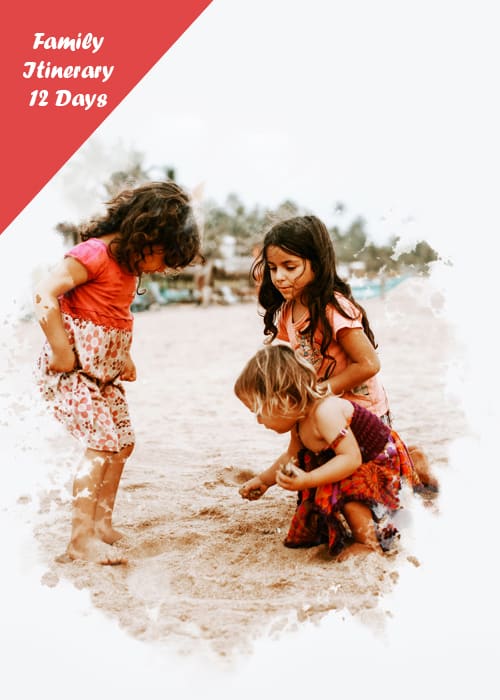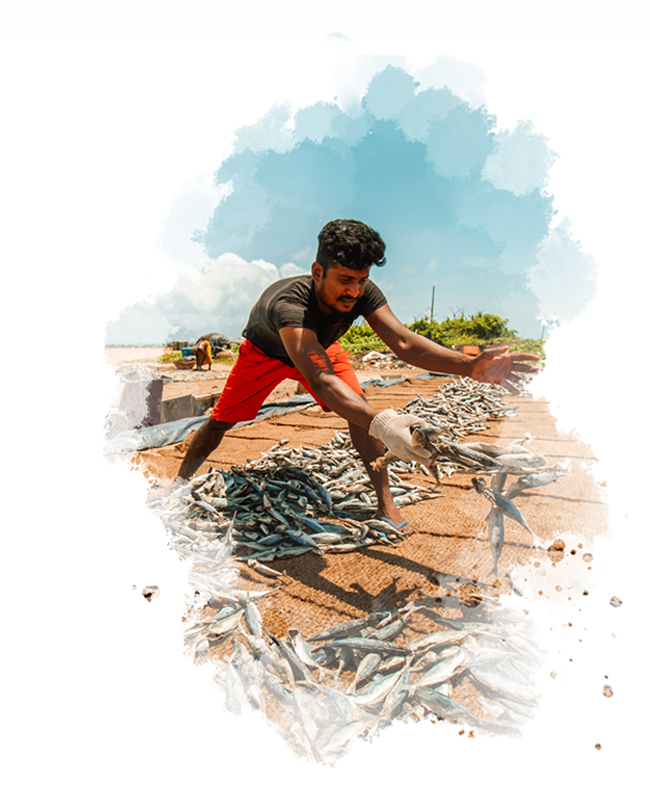
Negombo, Sri Lanka
Things to do, weather & itineraries
Perched on the west coast of Sri Lanka, the city of Negombo or “Little Rome” stands as a remnant of the island’s colonial past that offers a bite-sized introduction to the local culture and community. Known for its old-world charm, Negombo’s landscape is made up of ornate cathedrals and a centuries-old fishing industry, as well as extravagant resorts that lie beside the blue-grey waters of the sea, making it a must-see destination on every itinerary.
As the starting point for most tours, Negombo’s closeness to the airport makes it especially ideal for travellers to rest before embarking on their island adventure. Its main attractions are a curious mix of chaotic and laid-back, involving a stroll through the bustling Fish Market, a boat safari through the Muthurajawela Wetlands, and a drive to Colombo for a tour of the city.
The average daytime temperatures in Negombo range from 24°C (75.2°F) to 31°C (87.8°F), with the heat reaching an all-time high in April. Most travellers visit Negombo in the period between mid-December and mid-April to experience the best weather without heavy rainfall

Negombo, Sri Lanka
Things to do, weather & itineraries
Perched on the west coast of Sri Lanka, the city of Negombo or “Little Rome” stands as a remnant of the island’s colonial past that offers a bite-sized introduction to the local culture and community. Known for its old-world charm, Negombo’s landscape is made up of ornate cathedrals and a centuries-old fishing industry, as well as extravagant resorts that lie beside the blue-grey waters of the sea, making it a must-see destination on every itinerary.
As the starting point for most tours, Negombo’s closeness to the airport makes it especially ideal for travellers to rest before embarking on their island adventure. Its main attractions are a curious mix of chaotic and laid-back, involving a stroll through the bustling Fish Market, a boat safari through the Muthurajawela Wetlands, and a drive to Colombo for a tour of the city.
The average daytime temperatures in Negombo range from 24°C (75.2°F) to 31°C (87.8°F), with the heat reaching an all-time high in April. Most travellers visit Negombo in the period between mid-December and mid-April to experience the best weather without heavy rainfall.
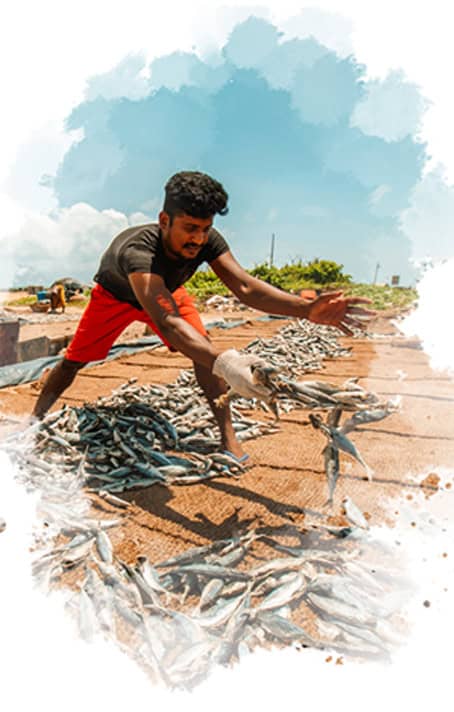
Negombo, Sri Lanka
Things to do, weather & itineraries
Perched on the west coast of Sri Lanka, the city of Negombo or “Little Rome” stands as a remnant of the island’s colonial past that offers a bite-sized introduction to the local culture and community. Known for its old-world charm, Negombo’s landscape is made up of ornate cathedrals and a centuries-old fishing industry, as well as extravagant resorts that lie beside the blue-grey waters of the sea, making it a must-see destination on every itinerary.
As the starting point for most tours, Negombo’s closeness to the airport makes it especially ideal for travellers to rest before embarking on their island adventure. Its main attractions are a curious mix of chaotic and laid-back, involving a stroll through the bustling Fish Market, a boat safari through the Muthurajawela Wetlands, and a drive to Colombo for a tour of the city.
The average daytime temperatures in Negombo range from 24°C (75.2°F) to 31°C (87.8°F), with the heat reaching an all-time high in April. Most travellers visit Negombo in the period between mid-December and mid-April to experience the best weather without heavy rainfall.
Tour itineraries featuring Negombo
As the first stop on most itineraries, Negombo offers a small selection of activities that will neither overwhelm you nor take up too much of your time. The highlights of the region include the Fish Market, the Muthurajawela Boat Safari, and the Colombo City Tour. If you would like to see how these excursions fit into a tour of Sri Lanka, you may refer to the itineraries below.
Tour itineraries featuring Negombo
As the first stop on most itineraries, Negombo offers a small selection of activities that will neither overwhelm you nor take up too much of your time. The highlights of the region include the Fish Market, the Muthurajawela Boat Safari, and the Colombo City Tour. If you would like to see how these excursions fit into a tour of Sri Lanka, you may refer to the itineraries below.
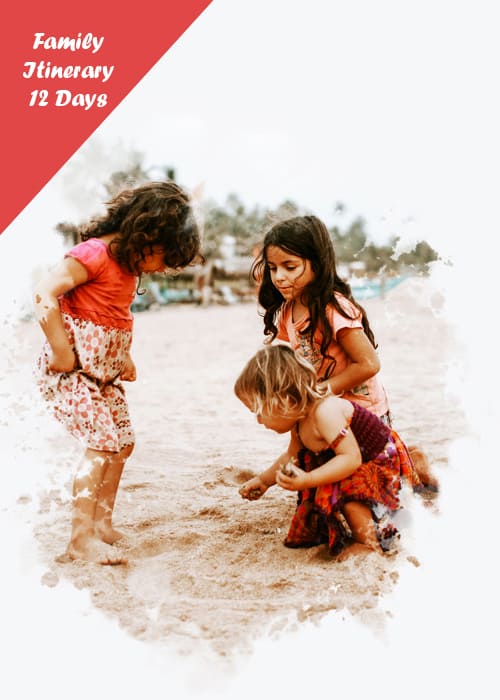
Sri Lanka with Toddlers
Enjoy the best of Sri Lanka with your little ones. A slow-paced family holiday for people travelling with toddlers.

Sri Lanka with a Baby
Discover the beauty of Sri Lanka with the new member of your family. A slow-paced itinerary for travelling with babies.
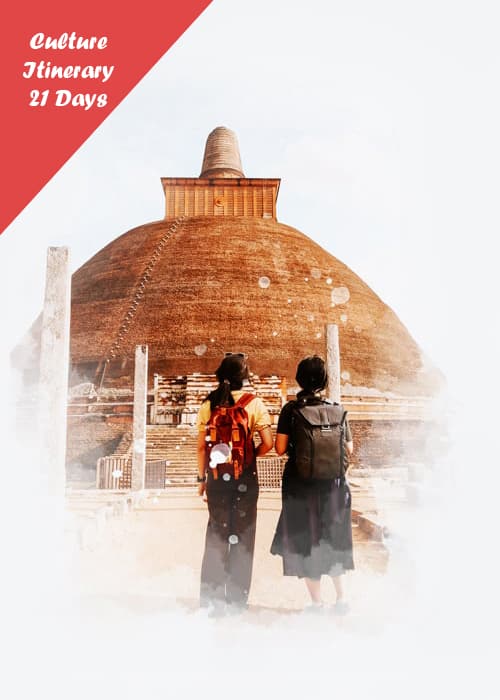
Sri Lanka in 3 Weeks
Enjoy the wildlife, nature, culture, history, and the local life of Sri Lanka with a perfect three-week Sri Lanka holiday.
Request a Free Quotation
Would you like to get our assistance to organize your Sri Lanka holiday? Drop us a message to get a tailor-made Sri Lanka holiday package that reflects your interests, budget, tour duration and the weather conditions of the month that you visit Sri Lanka.
Things to do in Negombo
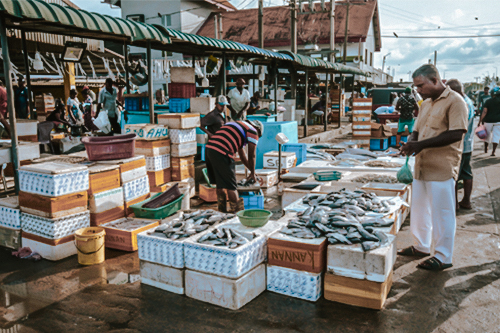
Locally known as Lellama, the Negombo Fish Market bustles with activity from the fisherfolk that form the bulk of the region’s population, and this has secured its reputation as the most famous open-air marketplace on the island. As one of the must-sees of Sri Lanka, this fish market offers some valuable insight into the fishing industry, and it provides an excellent opportunity for travellers to witness the fishing community in action.
The atmosphere here is chaotic; while buyers bargain for the best prices in loud voices, the fishermen oversee the sale of sharks, barracudas, mackerel, crabs, sardines, and other varieties of fresh seafood on display. This sensory experience of sights and smells reflects the island’s rich marine biodiversity, and the range of fish that is hauled in on a daily basis is guaranteed to impress those who are touring the region.
By 5AM, the marketplace roars to life as the fishermen return from the sea with their catch, which is then moved to either the wet market or the dry market. At the wet market, sellers who have bought fish wholesale from elsewhere set up their stalls beside the fisherfolk, and prepare to sell their fresh seafood to potential customers. This section also operates similarly to an auction house, as seafood is sold in bulk to hotels and restaurants for cheap prices.
On the other hand, the dry market on the beachfront will introduce you to traditional methods of seafood preservation. It is here that the fishermen clean, gut, dry and salt their catch under the sunlight and sea breeze, which ultimately gives the seafood a salty tang when it is cooked.
The Negombo Fish Market bustles with activity between 5AM and 8AM, which is coincidentally the best time to stop by and watch the auctions that are underway. Visiting any later than this is out of the question as most of the fish have been sold off by then. However, please note that the market is closed on Sundays since most of the fisherfolk attend Church instead.

The coastal wetlands of Muthurajawela are a tangle of mangrove swamps, reeds, and marshlands that converge at the Negombo Lagoon, creating a biodiversity hotspot that shelters over 102 species of birds as well as plenty of other butterfly, reptile and plant varieties. With lush greenery, calm waters, and guaranteed animal sightings along the way, this boat safari promises the adventure of a lifetime for wildlife enthusiasts of all ages.
Historical records reveal that the wetlands were named after Muttu Rajah—a royal commissioner who supervised paddy cultivation for King Parakramabahu the VIII (1484-1518). Today, the wetlands form a sanctuary that is home to egrets, moorhens, kingfishers, pelicans, and other bird species that make it a paradise for birdwatchers. You may even spot monitor lizards, crocodiles, fishing cats, and other animals in action.
On the other hand, the shrimp, mud crabs, seabass, and other aquatic animals in its waters are a vital source of income for the fisherfolk, who have built their houses around the lagoon. You may observe them paddling on their boats, casting their nets, and lying in wait to reel in their catch of the day by sunset.
A boat safari in the Muthurajawela Marsh begins with a short trip to one of the partially submerged islands in the area, where you can sit down and enjoy some fresh fruit as the water laps against your heels. Once you have eaten your fill, you will be taken to the famed Monkey Island, and your guide will ask you to place some of the leftover fruit on the deck for the toque macaques to feed on.
While it is generally not recommended to feed wild animals like this, it is a necessity for Monkey Island, where the macaques have nothing to eat. Their daily meals come from the fresh fruit that is provided to travellers during these boat safaris, so this practice is completely ethical and enjoyable, especially for younger children.
A boat safari through the wetlands may take 1 to 2 hours to complete, and it is best to begin your tour at 5PM. Doing so will give you the opportunity to watch the sunset along the way, and you can admire how the fishermen blend into the backdrop of fiery skies and overgrown mangroves.
Please note that you will be provided with life jackets before boarding the boat, which can carry around eight adults at maximum capacity.
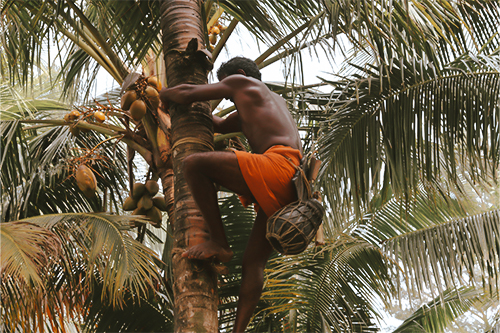
Centuries before beer and wine were brought over to Sri Lanka by foreign captives and colonial powers, the ancient kings that ruled over the island consumed raa or toddy—a sweet, mild, and pungent beverage with an alcohol content of four percent.
Of the three types of toddy that are produced around the island, pol raa is the most common in Negombo, and it is obtained from the sap of the coconut tree. On the other hand, kithul raa and thal raa come from the kithul and palmyra palms that are found in other parts of the country.
The art of collecting toddy is complex and dangerous. Toddy tappers climb coconut palms that are connected by a tightrope, and balance themselves with ease as they beat the coconut flowers with a small club. This process continues for three days, after which they collect the sap in a bottle or pot. The sap then undergoes natural fermentation within hours to become toddy.
Toddy is generally collected on-demand as it becomes vinegar when it is stored for too long. Since it is somewhat easy to obtain in Negombo, you may even have the opportunity to watch as toddy tappers scale the trees and gather the sap in small quantities.
If you would like to try this beverage during your stay in Negombo, you may ask your hotel staff or tour guide for some assistance. They will be able to make the necessary arrangements for you to enjoy toddy before you move on to the next part of your tour.
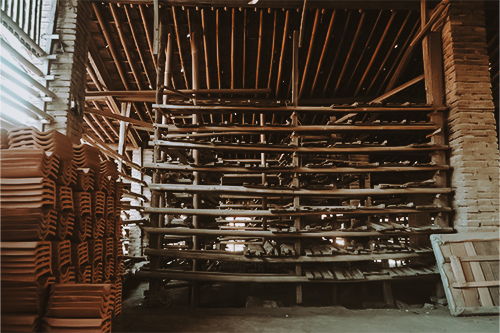
Over the years, Negombo has established itself as a prime location for the production of clay tiles, and today, it continues to supply tiles to different parts of the country. Visiting one of its many factories is an eye-opening experience for travellers to observe how the locals employ traditional methods to create their roof tiles.
The demand for clay tiles in Sri Lanka has always been high, partly due to their aesthetically pleasing appearance, but mostly because of their tendency to reflect the heat. To keep up with this demand, many factories were opened in and around the region.
A trip to the nearest tile factory will only take a few minutes of your time. You can watch as the clay pulp is prepared and pressed with old machines to form the shape of a tile. These shaped tiles are then stored to get rid of any excess humidity before they are warmed, baked and cooled in a firewood kiln.
Although many of these factories could speed up the production process with the latest technology, most choose to reject modernity and embrace tradition.
A tour of a tile factory is self-explanatory, and you will not require the assistance of a guide to understand what is going on. However, you can inquire about the process from the locals who are at work, and they will be happy to explain the role they play in producing each tile.
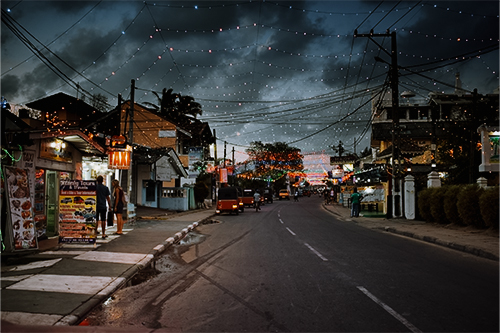
With plenty of restaurants, cafes, bars and spas scattered along the coastline, Negombo’s nightlife caters almost exclusively to tourists, and its laid-back ambience makes it easy to swing by for a cocktail or a snack anytime. Under the kaleidoscope of lights and live music in the tourist zone, you can choose from local, international and fusion cuisine, and enjoy guest performances from local artists until midnight.
Negombo’s nightlife also extends to the streetside boutiques and little shops that make up a part of its tourist zone. Most of them provide an opportunity to browse and shop for traditional paintings, devil masks, handloom fabrics that are soft to the touch, and all kinds of other souvenirs that will help you recall your island adventure when you are back home.
However, please note that if you wish to enjoy the best of Negombo’s nightlife, you must stay within its tourist zone. This is because the main town becomes extremely quiet after 10PM, which is when most of the shops have closed for the day and the residents in the area have turned in for the night.
Frequently Asked Questions
1. Is Negombo worth visiting?
Of course. Negombo is absolutely worth a visit during your tour of Sri Lanka for multiple reasons. Even though its range of activities pale in comparison with most other parts of the country, it makes up for this by offering a short yet memorable introduction to the local culture and community.
A tour of the streets paints a vivid picture of the lives led by the locals, whose friendliness will make you feel right at home. Meanwhile, the rich biodiversity of its coastal wetlands makes it a popular pick among families with children, letting them observe birds from afar as they feed a troop of mischievous monkeys. Ultimately, its chaotic marketplace, sandy beaches, and few activities make it a unique region to tour, with many experiences that cannot be replicated in any other part of the country.
Moreover, its closeness to the airport makes it the ideal location for the first or last night of your trip. If you decide to make Negombo your first stop, it will ease you into your island adventure and prepare you for what you can expect during the rest of your tour. However, if you choose to end your tour with a night in Negombo, you can kick back and relax with its laid-back ambience and purchase some last-minute souvenirs before you head back home.
2. Why is Negombo famous?
At a glance, Negombo may seem as though it does not have much to offer, but it gets its fame from its historical significance as well as its thriving community, both of which reflect the vibrant culture of the island.
Historical records reveal that Negombo’s natural harbour made it a key player in Sri Lanka’s ancient spice trade. However, it was not until the arrival of the Portuguese that the country’s cinnamon cultivation began to thrive, as they took the initiative to plant crops in Negombo and its surrounding villages. Today, however, Negombo is best known for its fishing industry along with its population of fisherfolk, and many travel from afar to experience the hustle and bustle of the Fish Market.
Negombo also has a reputation for its large Christian community. In fact, the ornate cathedrals in the city, which combine European architecture with Sri Lankan paintings of Christ and various saints, are the reason why Negombo is known as “Little Rome”.
Apart from this, the city’s popularity also comes from its tourist zone—a mini district of resorts, spas, shops and bars that appeal to those who are passing by. Travellers from across the globe tend to gather here for drinks and entertainment during their stay.
3. Can you swim in Negombo Beach?
No, you cannot swim in Negombo Beach. Although its shores are generally clean, its waters are unfit for swimming and bathing.
In fact, Negombo Beach is better suited for those who are not keen on water sports and other activities that get their blood pumping. Most travellers take a stroll along the coast instead, only pausing to dip their toes in the cooling waters when the waves tumble toward the shore. Others tend to stop by the cafes and restaurants that occupy the beachfront for a taste of the city’s specialty—seafood.
However, if you wish to swim in one of Sri Lanka’s beaches, you can make the necessary arrangements with your guide for a short stay in Hikkaduwa, Unawatuna, Bentota, or any other beach in the southern coastal stretch.
At Travellers Isle, we generally include a beachside stay at the end of our itineraries, so even though you cannot swim in Negombo Beach, you will still have an opportunity to test the waters in another part of the island.
4. How long should I stay in Negombo?
At most, you will need 1 to 2 days to experience all of Negombo’s attractions at a leisurely pace. However, you can easily complete some of its main excursions in a day before moving on to the next part of your tour.
More Tips for Your Holiday
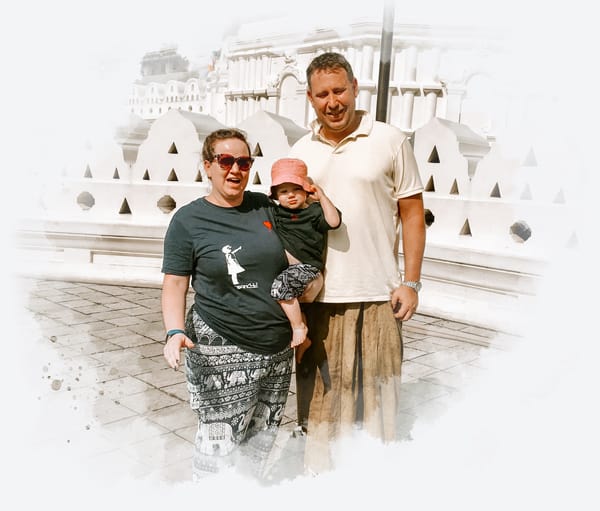
"We have had our amazing driver taking us around Sri Lanka with our 15 month old daughter for the last two weeks. Everything has been organized for us and everything has been perfect.Anyone thinking about going to Sri Lanka with their little ones should book with Travellers Isle. Nothing has been too much trouble for them. All hotels have been fabulous and our driver has been so helpful, amazing with our daughter, professional and knowledgeable."

